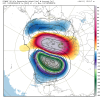Webberweather53
Meteorologist
The placement of the ridge in Alaska and near Scandinavia at day 2-3 is exactly where you'd want them to be if you were rooting for a split of the polar vortex in the long range. A negative height anomaly over Eurasia coupled w/ a strong Scandinavian block oth would favor displacement.

Taken from Maritus, Polvani, & Davies (2009).

Henceforth, a little over a week later, whola the vortex splits in half.


Taken from Maritus, Polvani, & Davies (2009).

Henceforth, a little over a week later, whola the vortex splits in half.




